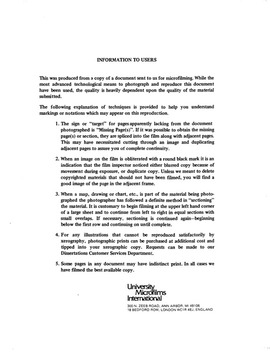| dc.contributor.advisor | De Stwolinski, Gail, | en_US |
| dc.contributor.advisor | Bell, Digby, | en_US |
| dc.contributor.author | Johnson, Mary Imogene Evans. | en_US |
| dc.date.accessioned | 2013-08-16T12:27:49Z | |
| dc.date.available | 2013-08-16T12:27:49Z | |
| dc.date.issued | 1979 | en_US |
| dc.identifier.uri | https://hdl.handle.net/11244/4610 | |
| dc.description.abstract | *Originally published in DAI Vol. 40, No. 5. | en_US |
| dc.description.abstract | However, this recognition does not necessarily solve the performance problems. Difficulties arise particularly with consecutive all-tying, diluted melodic identity in stretto, and inflecting hemiolic constructions. Apparently such problems are due to applying anachronistic performance conventions in these passages, compounded by lack of an overt tradition of conciliatory metrical inflection. Changing concepts of rhythm and meter between Schummann's time and ours have eroded the inflective presumptions of metrical notation to the point of replacing the "tyranny of the bar" with a "tyranny of surface factors." The new tyranny cancels the notated meter with its inflective expectations. But to Schumann, metrical expectation was an ally. Applying the new tyranny to his music drains his anomalies of their dramatic force.* | en_US |
| dc.description.abstract | They were found to be characteristically frequent, well-developed in a range of surface detail and formal position, and relatively comprehensive of Schumann's metrical irregularities. Some much less well developed anomalies appear: un-metered passages; polymeter; compound motion within simple meters; non-metrical beaming; metrical flexing; and unconventional or contradictory notation. The findings indicate the primacy of meter for Schumann's rhythmic thought. To him the divisive metrical armature normal in the early 19th century was an active inflective influence, not a passive measuring device. It functions independently of surface reinforcement. Schumann often carried anomalous procedures to an extreme, both in inventiveness (as in the numerous ways of anomalizing a barbeat) and in consecutive repetition of an irregular feature. His use of meter confirms a functional difference between stress and accent. Also significant is the texturally uni-metrical nature of music for a single performer. Hemioles were found to be a sub-division of metrical repositioning, on the evidence of specific usage, including overlapped and nested hemiolic constructions, initial hemioles, and partially hemiolic textures. | en_US |
| dc.description.abstract | Certain of Schumann's metrically anomalous passages have long been subjects of complaint. Throughout this search for his rhythmic intention in such passages, it has been assumed that he did not mean to mystify, that in the context of his overall rhythmic practice the function of the oddities would become clear. | en_US |
| dc.description.abstract | The investigative types are anomalous structurally, in sonority, or in rhythmic function. Structural non-congruence is most common; however, lilt formation is rhythmically abnormal on one level, and empty barbeats exhibit anomalous sonority while remaining rhythmically normal. Meter shapes the non-congruencies, a procedure which, while it conciliates, also emphasizes their non-conforming character. Since Schumann's anomalies depend upon normal inflective presumptions for their effect, metrical inflection is the performer's basic resource for carrying out Schumann's rhythmic intentions. | en_US |
| dc.description.abstract | To this end, six types of conspicuous vagaries were identified: empty barbeats; lilt formation (end-stopped triplets); consistent metrical displacement; oblique harmonic rhythm (harmonic anticipation and implied suspension); metrical re-positioning; and hemiolic construction. These were then sought throughout Schumann's instrumental music. | en_US |
| dc.format.extent | 2 v. : | en_US |
| dc.subject | Schumann, Robert, 1810-1856 Criticism and interpretation. | en_US |
| dc.subject | Music. | en_US |
| dc.title | Characteristic metrical anomalies in the instrumental music of Robert Schumann: A study of rhythmic intention. | en_US |
| dc.type | Thesis | en_US |
| dc.thesis.degree | Ph.D. | en_US |
| dc.thesis.degreeDiscipline | School of Music | en_US |
| dc.note | Major Professors: Gail De Stwolinski; Digby Bell. | en_US |
| dc.note | Source: Dissertation Abstracts International, Volume: 60-12, Section: A, page: 4242. | en_US |
| ou.identifier | (UMI)AAI7923786 | en_US |
| ou.group | Weitzenhoffer Family College of Fine Arts::School of Music | |
